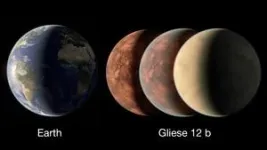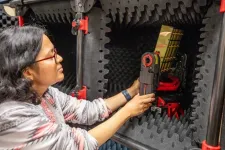(Press-News.org) Potentially habitable 'exo-Venus' with Earth-like temperature discovered
Royal Astronomical Society press release
RAS PR 24/12
Embargoed until 15:00 BST on Thursday 23 May 2024
Astronomers have made the rare and tantalising discovery of an Earth-like exoplanet 40 light-years away that may be just a little warmer than our own world.
The potentially-habitable planet, named Gliese 12 b, orbits its host star every 12.8 days, is comparable in size to Venus - so slightly smaller than Earth - and has an estimated surface temperature of 42°C (107°F), which is lower than most of the 5,000-odd exoplanets confirmed so far.
That is assuming it has no atmosphere, however, which is the crucial next step to establishing if it is habitable.
It may have an Earth-like atmosphere, one more akin to Venus - which experienced a runaway greenhouse effect that made it a 400°C (752°F) hellhole - no atmosphere, or perhaps a different kind of atmosphere not found in our solar system.
Getting an answer is vital because it would reveal if Gliese 12 b can maintain temperatures suitable for liquid water - and possibly life - to exist on its surface, while also unlocking answers about how and why Earth and Venus evolved so differently.
Gliese 12 b is by no means the first Earth-like exoplanet to have been discovered, but as NASA has said, there are only a handful of worlds like it that warrant a closer look.
It has been billed as "the nearest, transiting, temperate, Earth-size world located to date" and a potential target for further investigation by the US space agency's £7.5billion James Webb Space Telescope.
The closest Earth-like exoplanet to us - and possibly the most famous - is Proxima Centauri b, which is only 4 light-years away. However, because it is not a transiting world we still have a lot to learn about it, including whether it has an atmosphere and the potential to harbour life.
Most exoplanets are discovered using the transit method, where a planet passes in front of its star from our point of view, causing a dip in the host star's brightness.
During a transit, the star's light also passes through an exoplanet's atmosphere and some wavelengths get absorbed. Different gas molecules absorb different colours, so the transit provides a set of chemical fingerprints that can be detected by telescopes like Webb.
Gliese 12 b could also be significant because it may help reveal whether the majority of stars in our Milky Way galaxy - i.e. cool stars - are capable of hosting temperate planets that have atmospheres and are therefore habitable.
The discovery of the 'exo-Venus', by two international teams of astronomers, has been published today in the Monthly Notices of the Royal Astronomical Society.
It orbits a cool red dwarf star called Gliese 12, which is almost 40 light-years away from Earth in the constellation Pisces.
"Gliese 12 b represents one of the best targets to study whether Earth-size planets orbiting cool stars can retain their atmospheres, a crucial step to advance our understanding of habitability on planets across our galaxy," said Shishir Dholakia, a doctoral student at the Centre for Astrophysics at the University of Southern Queensland in Australia.
He co-led a research team with Larissa Palethorpe, a doctoral student at the University of Edinburgh and University College London.
The exoplanet's host star is about 27 per cent of the size of our Sun and has a surface temperature that is around 60 per cent of our own star.
However, the distance separating Gliese 12 and the new planet is just 7 per cent of the distance between Earth and the Sun. Gliese 12 b therefore receives 1.6 times more energy from its star as Earth does from the Sun and about 85 per cent of what Venus experiences.
This difference in solar radiation is important because it means the planet's surface temperature is highly dependent on its atmospheric conditions. As a comparison to Gliese 12 b's estimated surface temperature of 42°C (107°F), Earth has an average surface temperature of 15°C (59°F).
"Atmospheres trap heat and - depending on the type - can change the actual surface temperature substantially," Dholakia explained. "We are quoting the planet's 'equilibrium temperature', which is the temperature the planet would be if it had no atmosphere.
"Much of the scientific value of this planet is to understand what kind of atmosphere it could have. Since Gliese 12 b gets in between the amount of light as Earth and Venus get from the Sun, it will be valuable for bridging the gap between these two planets in our solar system."
Palethorpe added: "It is thought that Earth's and Venus's first atmospheres were stripped away and then replenished by volcanic outgassing and bombardments from residual material in the solar system.
"The Earth is habitable, but Venus is not due to its complete loss of water. Because Gliese 12 b is between Earth and Venus in temperature, its atmosphere could teach us a lot about the habitability pathways planets take as they develop."
The researchers, along with another team in Tokyo, used observations by NASA's TESS (Transiting Exoplanet Survey Satellite) to help make their discovery.
"We've found the nearest, transiting, temperate, Earth-size world located to date," said Masayuki Kuzuhara, a project assistant professor at the Astrobiology Center in Tokyo, who co-led a research team with Akihiko Fukui, a project assistant professor at the University of Tokyo.
"Although we don't yet know whether it possesses an atmosphere, we've been thinking of it as an exo-Venus, with similar size and energy received from its star as our planetary neighbour in the solar system."
An important factor in retaining an atmosphere is the storminess of its star. Red dwarfs tend to be magnetically active, resulting in frequent, powerful X-ray flares.
However, analyses by both teams conclude that Gliese 12 shows no signs of such extreme behaviour, raising hopes that Gliese 12 b's atmosphere may still be intact.
"We know of only a handful of temperate planets similar to Earth that are both close enough to us and meet other criteria needed for this kind of study, called transmission spectroscopy, using current facilities," said Michael McElwain, a research astrophysicist at NASA's Goddard Space Flight Center in Greenbelt, Maryland, and a co-author of the Kuzuhara and Fukui paper.
"To better understand the diversity of atmospheres and evolutionary outcomes for these planets, we need more examples like Gliese 12 b."
At 40 light-years from Earth, Gliese 12 b is about the same distance as the TRAPPIST-1 system.
This is made up of seven planets, all roughly in Earth's size range and likely rocky, orbiting a red dwarf star.
Three of these are in the habitable zone but at least two - and probably all of them - have no atmosphere and are likely barren, dismissing hopes when they were first discovered eight years ago that they could be water worlds hosting life.
The new paper "Gliese 12 b, A Temperate Earth-sized Planet at 12 Parsecs Discovered with TESS and CHEOPS", Shishir Dholakia and Larissa Palethorpe et al., has been published in the Monthly Notices of the Royal Astronomical Society.
Media contacts
Sam Tonkin
Royal Astronomical Society
Mob: +44 (0)7802 877700
press@ras.ac.uk
Robert Massey
Royal Astronomical Society
Mob: +44 (0)7802 877699
press@ras.ac.uk
Claire Andreoli
NASA's Goddard Space Flight Center
claire.andreoli@nasa.gov
Science contacts
Shishir Dholakia
University of Southern Queensland
dholakia.shishir@gmail.com
Larissa Palethorpe
University of Edinburgh
larissa.palethorpe@ed.ac.uk
Images and captions
Gliese 12 b artist's impression
Caption: Gliese 12 b, which orbits a cool, red dwarf star located just 40 light-years away, promises to tell astronomers more about how planets close to their stars retain or lose their atmospheres. In this artist's concept, Gliese 12 b is shown retaining a thin atmosphere.
Credit: NASA/JPL-Caltech/R. Hurt (Caltech-IPAC)
Gliese 12 b size comparison
Caption: Gliese 12 b's estimated size may be as large as Earth or slightly smaller — comparable to Venus in our solar system. This artist's concept compares Earth with different possible Gliese 12 b interpretations, from one with no atmosphere to one with a thick Venus-like one.
Credit: NASA/JPL-Caltech/R. Hurt (Caltech-IPAC)
Further information
The new study "Gliese 12 b, A Temperate Earth-sized Planet at 12 Parsecs Discovered with TESS and CHEOPS", Shishir Dholakia and Larissa Palethorpe et al., has been published in the Monthly Notices of the Royal Astronomical Society.
It will be available here when the embargo lifts. To request a copy of the paper in advance, email stonkin@ras.ac.uk.
Notes for editors
About the Royal Astronomical Society
The Royal Astronomical Society (RAS), founded in 1820, encourages and promotes the study of astronomy, solar-system science, geophysics and closely related branches of science.
The RAS organises scientific meetings, publishes international research and review journals, recognises outstanding achievements by the award of medals and prizes, maintains an extensive library, supports education through grants and outreach activities and represents UK astronomy nationally and internationally. Its more than 4,000 members (Fellows), a third based overseas, include scientific researchers in universities, observatories and laboratories as well as historians of astronomy and others.
The RAS accepts papers for its journals based on the principle of peer review, in which fellow experts on the editorial boards accept the paper as worth considering. The Society issues press releases based on a similar principle, but the organisations and scientists concerned have overall responsibility for their content.
Keep up with the RAS on X, Facebook, LinkedIn and YouTube.
END
Potentially habitable 'exo-Venus' with Earth-like temperature discovered
2024-05-23
ELSE PRESS RELEASES FROM THIS DATE:
Earth twin or evil twin
2024-05-23
The discovery of a planet similar to Venus around a star in the neighborhood of the Solar System raises hopes that astronomers may someday unlock the secret to why life appeared on Earth.
The study of life in the Universe is difficult because we have only one example of a planet where life has been confirmed: Earth. It is difficult to say which characteristics of Earth are required for life to appear, and which are irrelevant. Until we find an “Earth twin” where the conditions for life also appeared, the best astronomers ...
Tracking down the genetic causes of lupus to personalize treatment
2024-05-23
Lupus is a lifelong, often painful and occasionally lethal autoimmune disease. Few treatments exist today beyond powerful steroids to knock down a patient's immune system — a therapy that has its own serious risks.
The good news is that new and promising treatments are in clinical trials. But the term lupus belies the fact that the disease has a variety of causes, which means that treatments will have to be highly personalized to guarantee that each patient is given the drug that targets the specific genetic mutation ...
New discoveries about the nature of light could improve methods for heating fusion plasma
2024-05-23
Both literally and figuratively, light pervades the world. It banishes darkness, conveys telecommunications signals between continents and makes visible the invisible, from faraway galaxies to the smallest bacterium. Light can also help heat the plasma within ring-shaped devices known as tokamaks as scientists worldwide strive to harness the fusion process to generate green electricity.
Now, scientists have made discoveries about light particles known as photons that could aid the quest for fusion ...
Lehigh University researchers explore innovative cable-based approach to aerial robotics
2024-05-23
When we think about drones, we tend to think about Amazon. But their potential is much greater, and arguably far more important, than dropping off a box of laundry pods by lunchtime (an idea that’s struggled to take off since Jeff Bezos floated it more than a decade ago).
Aerial robots could be a huge asset, saving time, money, and workers’ well-being, in industries like construction where humans often have to heft materials up multiple floors, says David Saldaña, an assistant professor of computer science and engineering. They could also deliver ...
Researcher charges ahead with new tech to power drones wirelessly
2024-05-23
Dr. Ifana Mahbub, assistant professor of electrical and computer engineering at The University of Texas at Dallas, has been awarded the Defense Advanced Research Projects Agency (DARPA) Director’s Fellowship to continue her research to develop wireless technology to recharge unmanned aerial vehicles (UAVs) in flight.
DARPA awards the fellowships to its Young Faculty Award recipients who demonstrate exceptional performance. Mahbub received a Young Faculty Award, which provided $500,000 over ...
Features of bloodstream infection among immunocompromised oncology patients presenting to the emergency department with fever
2024-05-23
Background and Aims
Oncology patients undergoing cancer treatment and experiencing episodes of fever are known to be at increased risk for invasive bacterial infection, including bloodstream infection. This study aimed to identify the incidence of bacteremia along with the bloodstream isolates for immunocompromised oncology patients referred to the emergency department (ED) due to fever.
Methods
Oncology patients with fever were referred to the ED according to a protocol previously reported. Virtually ...
How family economic insecurity can hurt child mental health
2024-05-23
COLUMBUS, Ohio – Economic difficulty caused by the COVID-19 pandemic led to a cascade of connected problems for some parents – resulting in mental health problems for their children, a new study suggests.
Researchers found that economic insecurity was linked to higher levels of depressive symptoms for parents, which was then associated with poorer relationship quality for the couples. That was linked with more harsh parenting and then to increased internalizing behaviors for their children.
“Pandemic-induced ...
Constantly on the hunt for food: Harbor porpoises more vulnerable than previously thought to the disturbances from humans
2024-05-23
Summer is coming and that means more boats in the sea. Danish coastal waters are especially cluttered with small boats in the summertime. Locals water skiing, going fishing or just riding around the beautiful bays and fjords.
In general people relax and have a good time on the water, but that is unfortunately not the case for the harbor porpoise.
The more motor boats speeding noisily around, the more they are disturbed. And that can be a big problem for the animals.
Because the harbor porpoise is a relatively large animal that feeds on small fish it needs to spend a lot of time hunting. New research shows that it spends around 60 percent of its time on the hunt, but ...
Producing novel liquid crystals by stacking antiaromatic units
2024-05-23
In organic chemistry, π-stacking systems are supramolecular structures that arise due to the dispersion force, a type of intermolecular noncovalent interaction. They are a common occurrence in nature; the stabilized structure of DNA is a very prominent example of a π-stacking system, and so are the arrangement of amino acids in certain proteins. Interestingly, π-stacking can be leveraged in the design of materials with useful electronic and optical properties. These include organic semiconductors of various kinds, as well as conjugated polymers for sensing and biomedical applications.
Thus far, a good portion of technologically relevant π-stacking system has been limited ...
First pictures from Euclid satellite reveal billions of orphan stars
2024-05-23
The first scientific pictures from the Euclid satellite mission have revealed more than 1,500 billion orphan stars scattered throughout the Perseus cluster of galaxies.
Led by astronomers from the University of Nottingham, this discovery sheds light on the origins of these celestial wanderers.
The Perseus cluster, located 240 million light-years away from Earth, is one of the Universe's most massive structures, boasting thousands of galaxies. However, amidst this cosmic ensemble, the Euclid satellite captured faint ghostly light - the orphan stars - drifting between the cluster's galaxies.
Stars naturally form within galaxies, so the presence of orphan ...








